September 2016 Update
Rescued fish and offspring reared and released to the wild!
Table 1: McCloud River Redband Trout September 2016 releases
| McCloud Tributary |
Released Rescued Adults |
Released BY2015 Offspring |
Totals |
| Edson |
90 |
0 |
90 |
| Sheepheaven |
50 |
0 |
50 |
| Moosehead |
44 |
254 |
298 |
| Swamp |
149 |
0 |
149 |
| Trout |
0 |
453 |
453 |
| Grand Total |
|
|
1040 |
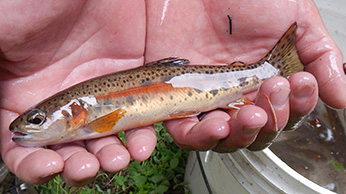
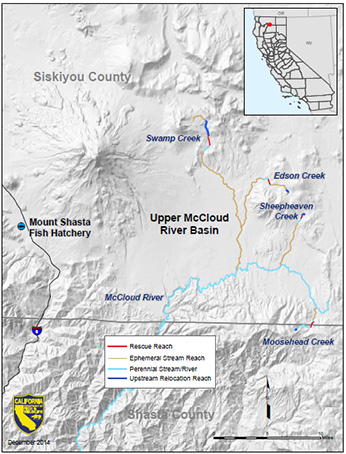 (click/tap to enlarge)
(click/tap to enlarge)
Severe drought and shrinking stream habitat in 2013 and 2014 led to emergency rescues of McCloud River Redband Trout from headwater streams in the upper McCloud River basin. During the more critical dry periods of the drought, suitable stream habitat was not available for in-stream or in-basin relocations and fish were moved to the Mount Shasta Hatchery providing a safe-haven until habitat conditions improved (see full story below). To reduce hatchery domestication effects, CDFW employed naturalized rearing techniques by introducing artificial, but natural looking wood and root wads, cobble from the natal streams, and shade cloth to mimic dark cover (Figure 1). The rescued fish and offspring were also transitioned to terrestrial insects along with their regular diet, a few weeks prior to release into the wild.
Most trout were returned to their natal streams, and a small percentage were released into other redband streams in order to enhance genetic complexity, as recommended by fisheries geneticists (Table 1).
Approximately two weeks prior to the reintroduction activities, all fish were tagged with passive integrated transponder, or PIT tags, and individual fish lengths and weights were recorded (Figure 3). The specific information on each released fish will help biologists better evaluate the rescue/rearing/reintroduction effort for McCloud Redband Trout by gathering information on growth, fish movement, and reintroduction/family success over time.
In 2017, the CDFW will follow up the 2016 effort with an additional outplanting of fish, this time comprising of 2015 brood year and 2016 brood year captive offspring.
For questions please contact Mike Dege, Michael.Dege@wildlife.ca.gov
- Dege, M., E. Jones, M. Clifford and C. Kittel. 2016. Providing safe haven for sensitive aquatic species in a changing climate. Fisheries, 41(7):395-396.
- Weir, Mike. 2016. McCloud Redband reintroduction. The Current (Fall 2016):30-35.
- Weir, Mike. 2016. McCloud River Redband rescue and recovery [Video].
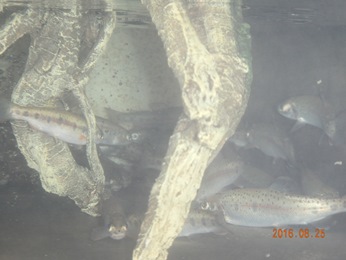 Figure 1: McCloud River Redband Trout in hatchery tank with wood enhancements.
Figure 1: McCloud River Redband Trout in hatchery tank with wood enhancements.
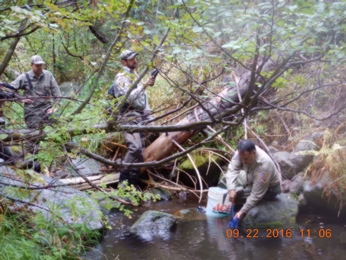 Figure 2: CDFW biologists released McCloud River Redband Trout to native trout streams.
Figure 2: CDFW biologists released McCloud River Redband Trout to native trout streams.
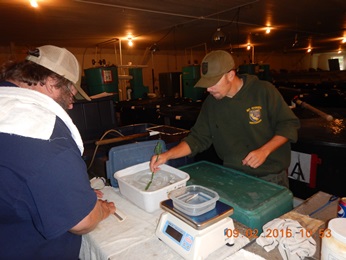 Figure 3: McCloud River Redband Trout were tagged with PIT tags before release.
Figure 3: McCloud River Redband Trout were tagged with PIT tags before release.
Genetically Unique Subspecies
McCloud River Redband Trout, Oncorhynchous mykiss stonei, represent a genetically distinct subspecies of rainbow trout and are listed as a CDFW Species of Special Concern. McCloud River Redband Trout are found in the upper McCloud River basin in small isolated streams (Shasta and Siskiyou counties).
Necessity of Rescue
The small isolated streams in the upper McCloud basin have limited flow and wetted habitat which make them more vulnerable to changes in the environment (Figure 1). Loss of wetted habitat due to extreme drought conditions required staff to initiate rescue and relocation activities in Sheepheaven, Edson, Swamp and Moosehead Creeks (Figure 2).
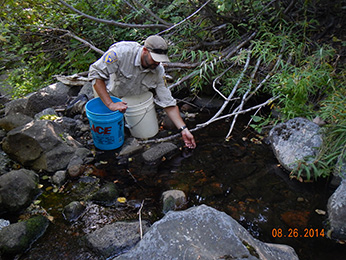 Figure 1.
Figure 1.
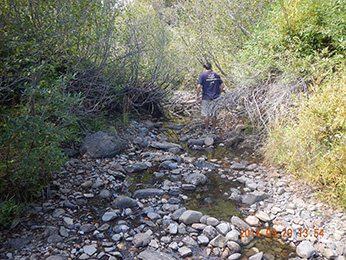 Figure 2.
Figure 2.
Relocation Sites
If adequate flow existed, fish were relocated to suitable habitats within the existing stream or suitable habitat within another stream identified as a genetically distinct McCloud redband trout stream. If no stream habitat was available, fish were relocated to the Mount Shasta Hatchery “safe haven” isolation tanks (map).
Rescue Methods
During early rescue efforts field crews identified in-stream relocation sites for 465 fish collected from all four creeks. By late August and early September surface flow and available fish holding habitat in the streams continued to diminish forcing an additional 1,012 rescued McCloud River Redband Trout to be moved into the Mount Shasta Hatchery. Before any wild fish were relocated to the Mount Shasta Hatchery, live chill boxes, bio-filtration and UV-treated circulation tanks were purchased and installed (Figure 3). Upon arrival at the hatchery, fish were chemically treated for potential parasitic and bacterial diseases, and segregated into three isolation tanks by stream (Edson, Moosehead and Swamp creeks) and size class (small, medium and large) (Figure 4). Sheepheaven Creek rescued fish were not relocated to Mount Shasta hatchery. The stream and size class isolation protocol was to prevent intermixing of stream stocks and to protect smaller fish from predation. CDFW Hatchery staff and pathologist closely monitored the trout while they adjusted to their new environment. The movement of wild fish into the hatchery was a last resort to protect and conserve McCloud River Redband Trout populations.
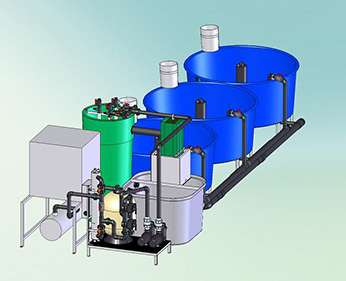 Figure 3.
Figure 3.
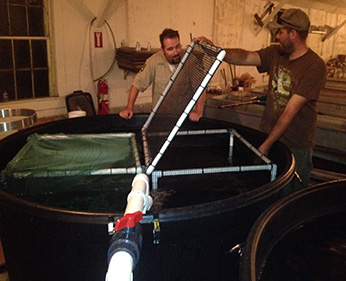 Figure 4.
Figure 4.
Fish Survival
Between November 2013 and September 2014, a total of 1,477 McCloud River redband trout were collected and successfully relocated. Every attempt was made to relocate fish to suitable habitats within the existing stream or, if necessary, within another stream identified as a genetically distinct McCloud redband trout stream. As a last resort, emergency isolation tanks were made available at Mount Shasta Hatchery.
Data
McCloud River Redband Trout Data
| |
Sheepheaven |
Edson |
Swamp |
Moosehead |
| |
Instream |
Hatchery |
Instream |
Hatchery |
Instream |
Hatchery |
Instream |
Hatchery |
| Collected |
129 |
0 |
51 |
224 |
249 |
534 |
45 |
285 |
| Mortalities |
8 |
0 |
1 |
11 |
0 |
4 |
0 |
16 |
| Relocated |
121 |
0 |
50 |
213 |
249 |
530 |
45 |
269 |
Future McCloud River Tributaries
Reintroduction plans to return the fish to their natal streams have not been finalized yet. Concern remains as to the persistence of McCloud River Redband Trout in the wild if long term drought conditions continue.
Collaborating Staff
CDFW Northern Region’s Heritage Trout program with assistance from Mount Shasta Hatchery staff, district biologists and flat-water management staff.
Project Permitting
Interagency Fish Rescue Policy (CDFW / NMFS / USFWS). Fish rescue by CDFW is exempt under CEQA.
CDFW Region 1